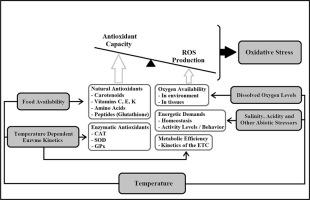Comparative Biochemistry and Physiology A: Molecular & Integrative Physiology ( IF 2.1 ) Pub Date : 2020-07-18 , DOI: 10.1016/j.cbpa.2020.110767 By Peter Baker 1 , Isabel Van Wie 1 , Evan Braun 1 , Ana Gabriela Jimenez 1

|
Climate change will increase the frequency, intensity, and duration of heatwaves. This thermal volatility will challenge to the oxidative homeostasis of aquatic ectotherms through many temperature-dependent environmental factors. In this study, we examined the effects of chronic exposure of sheepshead minnows (Cyprinodon variegatus) to multiple thermal regimes on the oxidative physiology of white muscle in these eurytolerant fish. The thermal treatments included stable (15 °C and 30 °C) and cycling regimes (between 21 and 29 °C at 6, 8 and 10-h intervals). The effect of these thermal treatments on oxidative stress during an acute thermal challenge (12 h at 32 °C) was also examined. Enzymatic activity of catalase (CAT), superoxide dismutase (SOD), and glutathione peroxidase (GPx), scavenging capacities of hydroxyl and peroxyl radicals, and lipid peroxidation (LPO) damage were quantified. We found no differences between or across treatments in any of the enzymatic antioxidants or LPO damage. We found that peroxyl radical scavenging was greatest at the peak of the 8- and 10-h thermal cycles. Peroxyl scavenging after an acute thermal challenge was greater than before the challenge for the steady 15 °C and 8-h cycle treatments, greater before the acute challenge for the steady 30 °C and 6-h cycle, and equivalent in the 10-h cycle. These findings demonstrate that even the most tolerant of marine ectotherms must engage oxidative defenses when presented with thermal variability and heighten concerns about the impact of climate change on less tolerant species.
中文翻译:

热稳定性与可变性:对耐性鱼的氧化应激的见解。
气候变化将增加热浪的频率,强度和持续时间。这种热挥发性将通过许多与温度有关的环境因素来挑战水生等温线的氧化稳态。在这项研究中,我们研究了长期暴露于羊头min鱼(Cyprinodon variegatus)的影响。)对这些抗性鱼的白肌的氧化生理有多种热机制。热处理包括稳定的温度(15°C和30°C)和循环方式(21至29°C,间隔6、8和10小时)。还检查了这些热处理对急性热挑战(在32°C下12 h)氧化应激的影响。量化了过氧化氢酶(CAT),超氧化物歧化酶(SOD)和谷胱甘肽过氧化物酶(GPx)的酶活性,清除羟和过氧自由基的能力以及脂质过氧化(LPO)的损害。我们发现任何酶抗氧化剂或LPO损伤之间或治疗之间没有差异。我们发现过氧自由基清除在8小时和10小时热循环的峰值处最大。在稳定的15°C和8小时的循环处理中,急性热挑战后的过氧化物清除量大于挑战之前,在稳定的30°C和6小时的循环中,在急性挑战之前的过氧化物清除量更大,在10小时内等效周期。这些发现表明,即使是最能容忍的海洋等温线在出现热变异性时也必须参与氧化防御,并加剧了人们对气候变化对不容忍物种的影响的担忧。











































 京公网安备 11010802027423号
京公网安备 11010802027423号